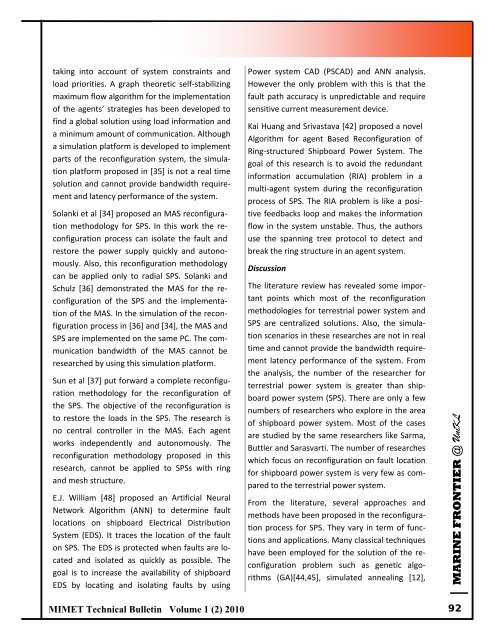click here to download - UniKL MIMET Official Website
click here to download - UniKL MIMET Official Website
click here to download - UniKL MIMET Official Website
You also want an ePaper? Increase the reach of your titles
YUMPU automatically turns print PDFs into web optimized ePapers that Google loves.
taking in<strong>to</strong> account of system constraints and<br />
load priorities. A graph theoretic self‐stabilizing<br />
maximum flow algorithm for the implementation<br />
of the agents’ strategies has been developed <strong>to</strong><br />
find a global solution using load information and<br />
a minimum amount of communication. Although<br />
a simulation platform is developed <strong>to</strong> implement<br />
parts of the reconfiguration system, the simula‐<br />
tion platform proposed in [35] is not a real time<br />
solution and cannot provide bandwidth require‐<br />
ment and latency performance of the system.<br />
Solanki et al [34] proposed an MAS reconfigura‐<br />
tion methodology for SPS. In this work the re‐<br />
configuration process can isolate the fault and<br />
res<strong>to</strong>re the power supply quickly and au<strong>to</strong>no‐<br />
mously. Also, this reconfiguration methodology<br />
can be applied only <strong>to</strong> radial SPS. Solanki and<br />
Schulz [36] demonstrated the MAS for the re‐<br />
configuration of the SPS and the implementa‐<br />
tion of the MAS. In the simulation of the recon‐<br />
figuration process in [36] and [34], the MAS and<br />
SPS are implemented on the same PC. The com‐<br />
munication bandwidth of the MAS cannot be<br />
researched by using this simulation platform.<br />
Sun et al [37] put forward a complete reconfigu‐<br />
ration methodology for the reconfiguration of<br />
the SPS. The objective of the reconfiguration is<br />
<strong>to</strong> res<strong>to</strong>re the loads in the SPS. The research is<br />
no central controller in the MAS. Each agent<br />
works independently and au<strong>to</strong>nomously. The<br />
reconfiguration methodology proposed in this<br />
research, cannot be applied <strong>to</strong> SPSs with ring<br />
and mesh structure.<br />
E.J. William [48] proposed an Artificial Neural<br />
Network Algorithm (ANN) <strong>to</strong> determine fault<br />
locations on shipboard Electrical Distribution<br />
System (EDS). It traces the location of the fault<br />
on SPS. The EDS is protected when faults are lo‐<br />
cated and isolated as quickly as possible. The<br />
goal is <strong>to</strong> increase the availability of shipboard<br />
EDS by locating and isolating faults by using<br />
<strong>MIMET</strong> Technical Bulletin Volume 1 (2) 2010<br />
Power system CAD (PSCAD) and ANN analysis.<br />
However the only problem with this is that the<br />
fault path accuracy is unpredictable and require<br />
sensitive current measurement device.<br />
Kai Huang and Srivastava [42] proposed a novel<br />
Algorithm for agent Based Reconfiguration of<br />
Ring‐structured Shipboard Power System. The<br />
goal of this research is <strong>to</strong> avoid the redundant<br />
information accumulation (RIA) problem in a<br />
multi‐agent system during the reconfiguration<br />
process of SPS. The RIA problem is like a posi‐<br />
tive feedbacks loop and makes the information<br />
flow in the system unstable. Thus, the authors<br />
use the spanning tree pro<strong>to</strong>col <strong>to</strong> detect and<br />
break the ring structure in an agent system.<br />
Discussion<br />
The literature review has revealed some impor‐<br />
tant points which most of the reconfiguration<br />
methodologies for terrestrial power system and<br />
SPS are centralized solutions. Also, the simula‐<br />
tion scenarios in these researches are not in real<br />
time and cannot provide the bandwidth require‐<br />
ment latency performance of the system. From<br />
the analysis, the number of the researcher for<br />
terrestrial power system is greater than ship‐<br />
board power system (SPS). T<strong>here</strong> are only a few<br />
numbers of researchers who explore in the area<br />
of shipboard power system. Most of the cases<br />
are studied by the same researchers like Sarma,<br />
Buttler and Sarasvarti. The number of researches<br />
which focus on reconfiguration on fault location<br />
for shipboard power system is very few as com‐<br />
pared <strong>to</strong> the terrestrial power system.<br />
From the literature, several approaches and<br />
methods have been proposed in the reconfigura‐<br />
tion process for SPS. They vary in term of func‐<br />
tions and applications. Many classical techniques<br />
have been employed for the solution of the re‐<br />
configuration problem such as genetic algo‐<br />
rithms (GA)[44,45], simulated annealing [12],<br />
| MARINE FRONTIER @ <strong>UniKL</strong><br />
92



